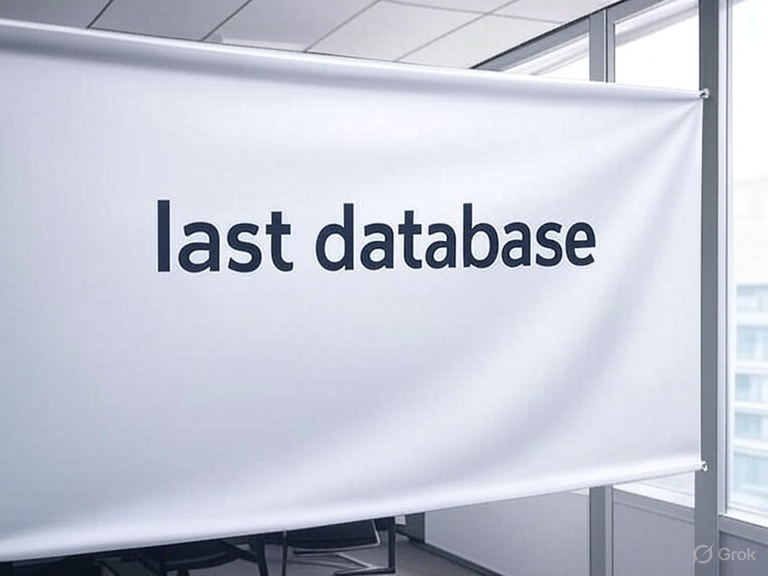This guide outlines the essential steps to buying a database, ensuring you make an informed decision that aligns with your specific needs last database and future goals.
1. Define Your Requirements: The Foundation of Your Decision
Before you even start looking at database vendors or technologies, the most crucial step is to clearly define what you need from a database. This involves a comprehensive assessment of your data, applications, and business objectives.

1.1. Understand Your Data
Data Volume: How much data do you have currently, and how much do you expect to have in the future (e.g., in 1, 3, or 5 years)? This includes both structured and unstructured data.
- Data Velocity: How quickly is new data generated and how frequently does it need to be
- updated? Consider peak loads and daily averages.
- Data Variety: What types of data will you be storing? (e.g., transactional, analytical, documents, images, videos, time-series data).
- Data Volatility: How often will the decision process: a structured approach data be read, written, or deleted? This helps determine your read/write ratio.
- Data Interrelationships: How is your data connected? Do you need strict relationships and referential integrity (relational) or more flexible, schema-less structures (NoSQL)?
1.2. Identify Application Needs
- Application Type: Are you building a web application, mobile app, IoT platform, data analytics dashboard, e-commerce site, or something else?
- Performance Requirements: What are
- fax marketing
- your latency and throughput demands? How many transactions per second (TPS) or queries per second (QPS) do you anticipate?
- Scalability: Do you need to scale vertically (more resources on a single server) or horizontally (distribute across multiple servers)?
- Concurrency: How many simultaneous users or connections will the database need to handle?
- High Availability & Disaster Recovery (HA/DR): What are your uptime requirements? How much data loss (RPO – Recovery Point Objective) and downtime (RTO – Recovery Time Objective) can you tolerate in case of a failure?
- Security: What are your data encryption, access control, and compliance requirements (e.g., GDPR, HIPAA)?
1.3. Business Objectives
- Budget: What is your allocated budget for database software, hardware, licensing, and ongoing maintenance?
- Team Expertise: What are the skill sets of your current IT team? Are they familiar with SQL, NoSQL, specific database technologies?
- Vendor Lock-in: How important is it to avoid being tied to a single vendor? Open-source options often provide more flexibility.
- Future Growth: How will the database support your long-term business strategy and potential new features or services?
2. Research and Evaluate Database Types
Once you have a clear understanding of your requirements, you can begin to explore the various types of databases available. Each type is optimized for different use cases.
2.1. Relational Databases (SQL)
- Characteristics: Structured data, tables with fixed schemas, strong consistency (ACID properties), joins.
- Use Cases: Transactional systems, financial applications, inventory management, CRM.
- Examples: MySQL, PostgreSQL, Oracle Database, Microsoft SQL Server.
2.2. NoSQL Databases
- Characteristics: Flexible schemas, horizontal scalability, eventually consistent or strong consistency (depending on type).
- Use Cases: Big data, real-time web applications, content management, IoT.
- Sub-types:
- Document Databases: Store data in flexible, semi-structured documents (e.g., MongoDB, Couchbase). Ideal for content management, catalogs.
- Key-Value Stores: Simple key-value pairs (e.g., Redis, DynamoDB). Good for caching, session management.
- Column-Family Stores: Store data in columns, optimized for large-scale data analytics (e.g., Cassandra, HBase).
- Graph Databases: Store data as nodes and edges, ideal for highly connected data (e.g., Neo4j, Amazon Neptune).
2.3. Cloud Databases
- Characteristics: Managed services, pay-as-you-go, high scalability, built-in HA/DR.
- Use Cases: Virtually any application where you want to offload infrastructure management.
- Examples: Amazon RDS, Amazon Aurora, Google Cloud SQL, Azure SQL Database, Snowflake.
2.4. Other Specialized Databases
- Time-Series Databases: Optimized for time-stamped data (e.g., InfluxDB, TimescaleDB).
- Search Engines: Optimized for full-text search (e.g., Elasticsearch, Apache Solr).
- Vector Databases: For AI/ML applications requiring similarity searches on embeddings (e.g., Pinecone, Weaviate).
